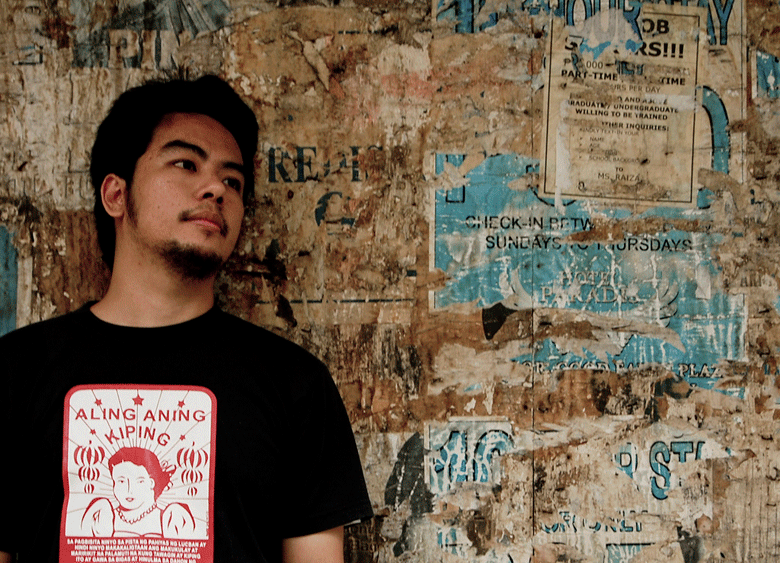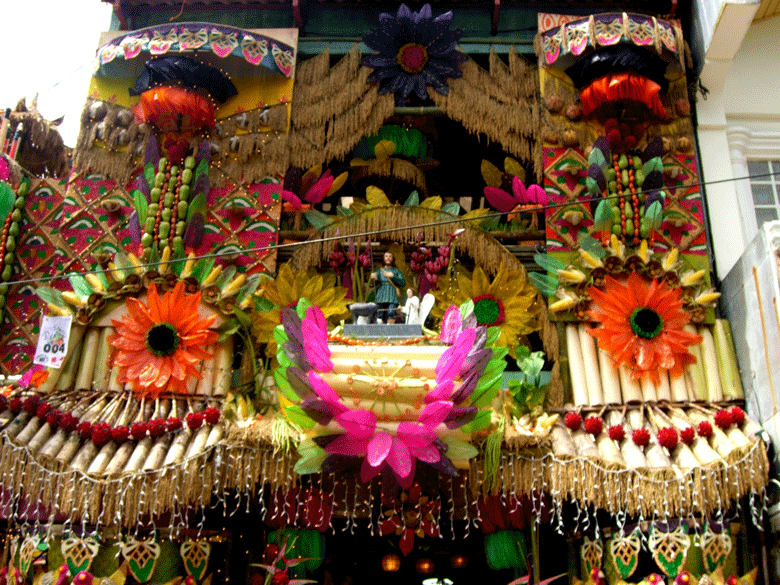
Photograph by Mark Vivas
Mark Salvatus's works has a lot to do with the city, employing art to create an urbanscape that is both aesthetically pleasing and feasible, and aimed at infusing the metropolis with a vibrant visual energy that go beyond Bayani Fernando's cheap puns (cheaper than this post's title, we mean: a street sign that says Lee Kuan Yew for Likuan U) and pink metal trimmings. Every third summer, however, Mark goes back to his hometown Lucban to help put together the family's Pahiyas decor which, he says, is a big influence on his more citified pursuits.
When I was 5 or 6, we lived in a small house at the center of Lucban. I helped during the preparation: simple decorations lang with kiping, some vegetables. It’s like the whole town was transformed into a wonderland--very colorful, very festive--like the Hansel and Gretel story where you can eat the houses. It’s a family thing, a communal gathering where everyone was involved. The route of the Pahiyas changes yearly so our area only gets to do the decoration every three years.
My lolo Ramon Salvatus was a local historian, poet, teacher and a former Municipal Secretary of Lucban (in the 70’s). I heard a lot of his stories about the San Isidro Festival. He also coined the term “Pahiyas” which means to decorate, and jewel (hiyas) refers to the rice grains and other produce.
Before the Spanish came to Lukban, the locals were already offering their produce and crafts as a sign of gratitude for a good harvest to the gods like the sky, water, trees etc. When the Spaniards came, they saw this ritual. They introduced San Isidro Labrador to the locals as the patron saint of farmers and told them to offer their harvests in honor of him.
The ritual of offering harvests evolved as a local Catholic celebration, wherein Lucbanins bring rice, vegetables, fruits etc to the church so the priest could bless them. The church got so jampacked with people and offerings, the parish priest decided that instead of the people bringing the produce to the church, he will go to their houses and bless the offerings there. So the locals displayed their best produce outside their homes.
Usually the family decides what to do. Everyone is involved. It’s like a big production. From studies, then production then to the presentation---the Pahiyas day itself. The materials used are local products/produce of Lucban, reflecting the livelihood of each house: longganisa, hats, bakya. Its possible to use other materials as long as its not synthetic or plastic. Some use bread, cotton candy, pansit habhab etc.
Usually the preparation takes about a week to 3 weeks. Meron ding mga simple lang, but the point is that they still participate in the celebration, kahit na simpleng bamboo with kiping okay na. But this last Pahiyas, I'm kind of disappointed with a lot of banners of politicians. Mukha nila ang naka-pahiyas--mukhang kamatis at talong.
The Pahiyas is some kind of a big installation art or public art. It is also some kind of collaborative art--a relational art- wherein people are part of the process of making it. My works now are process-oriented, involving the public and the environment. Like the Pahiyas, its about collaboration and public space. The communal aspect of my practice has a big impact on the tradition I grew up with. I always go back to Lucban if I have time to look for inspirations. The tradition makes us very creative. The lambanog doesn't hurt, too.
Pilipinas Street Plan, of which Mark is co-founder, has a show tonight at Pablo Gallery in Cubao X called Strip Stick and Drip. For Mark Salvatus' urban projects, visit marksalvatus.blogspot.com and pilipinastreetplan.blogspot.com.
Neo-Urban Plan is now accepting contributions that are related to matters on Philippine urbanity and the visual culture within the urban space - it may be photos, text, essay, drawings, experiences etc. email it to markrams@yahoo.com
Friday, May 29, 2009
KIPING IN TOUCH ] The urban planner returns to his Lucban roots
Subscribe to:
Post Comments (Atom)



No comments:
Post a Comment